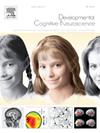Intersubject neural similarity reveals the development trajectory of recognition memory in children
IF 4.9
2区 医学
Q1 NEUROSCIENCES
引用次数: 0
Abstract
Recognition memory improves with child development, but the neural mechanisms underlying such improvement and the developmental variation remain poorly understood. Herein, we investigated how the neural representations during the encoding and retrieval phases of recognition memory change with age, using representational similarity analysis in a sample of children aged 6–13 years (n = 137). Our results indicated that the encoding and retrieval phases have distinct neural patterns of development. Similarly, using a model-free approach, we confirmed that there is a key developmental stage (about 9–10 years old) for the neural representation during the encoding phase, whereas the neural representation during the retrieval phase tends to be stable with child development. Additionally, we identified that the neural similarity between the encoding and retrieval phases in children is primarily located in the left parietal-occipital region. Overall, these findings refine the developmental process underlying memory representation and enhance our understanding of the neural mechanisms of recognition memory.
主体间神经相似性揭示了儿童识别记忆的发展轨迹
识别记忆随着儿童发育而改善,但这种改善和发育差异背后的神经机制仍然知之甚少。本文以6-13岁儿童为研究对象(n = 137),通过表征相似性分析,研究了识别记忆编码和检索阶段的神经表征随年龄的变化。结果表明,编码和检索阶段具有明显的神经发育模式。同样,使用无模型方法,我们证实了在编码阶段存在一个关键的神经表征发展阶段(约9-10岁),而在检索阶段的神经表征随着儿童发育趋于稳定。此外,我们发现儿童编码和检索阶段之间的神经相似性主要位于左侧顶叶-枕区。总的来说,这些发现完善了记忆表征的发展过程,增强了我们对识别记忆的神经机制的理解。
本文章由计算机程序翻译,如有差异,请以英文原文为准。
求助全文
约1分钟内获得全文
求助全文
来源期刊

Developmental Cognitive Neuroscience
NEUROSCIENCES-
CiteScore
7.60
自引率
10.60%
发文量
124
审稿时长
6-12 weeks
期刊介绍:
The journal publishes theoretical and research papers on cognitive brain development, from infancy through childhood and adolescence and into adulthood. It covers neurocognitive development and neurocognitive processing in both typical and atypical development, including social and affective aspects. Appropriate methodologies for the journal include, but are not limited to, functional neuroimaging (fMRI and MEG), electrophysiology (EEG and ERP), NIRS and transcranial magnetic stimulation, as well as other basic neuroscience approaches using cellular and animal models that directly address cognitive brain development, patient studies, case studies, post-mortem studies and pharmacological studies.
 求助内容:
求助内容: 应助结果提醒方式:
应助结果提醒方式:


